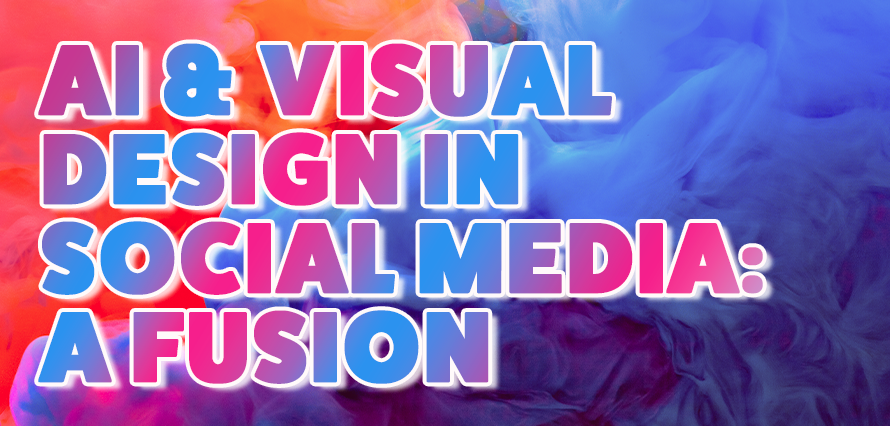October 5, 2023

In today’s digital age, social media has become an integral part of our lives. We scroll through countless images, videos, and graphics every day, often unaware of the sophisticated technologies working behind the scenes to deliver captivating content. One such technology making waves in the world of social media is Artificial Intelligence (AI). AI is revolutionising the way we create, share, and interact with visual content on social media platforms. In this blog, we’ll explore the fusion of AI and visual design in social media, highlighting its impact, benefits, and potential for the future.
The Power of Visual Content
Visual content is king in the world of social media. Images, videos, infographics, and other visually appealing content garner more engagement and attention compared to text-only posts. As a result, businesses and individuals alike have been investing heavily in visual design to stand out in the crowded social media landscape.
AI in Visual Design
AI is a game-changer in visual design because it can automate and enhance various aspects of content creation and curation. Here are some key ways in which AI is transforming visual design on social media:
- Image Recognition: AI-powered algorithms can analyse the content of images and videos, making it easier to categorise, tag, and sort visual content. This enables more efficient content organisation and retrieval.
- Auto-Editing: AI-driven photo and video editing tools can automatically adjust lighting, colours, and composition to enhance the visual appeal of content. Apps like Adobe Sensei and Canva use AI to simplify editing for users with no design experience.
- Content Generation: AI-generated content is becoming more sophisticated. Chatbots and AI-powered systems can create personalised visual content like infographics, product recommendations, and promotional graphics.
- Visual Search: Social media platforms like Pinterest and Instagram are implementing visual search features that use AI to recognize objects within images and suggest related content or products.
- Predictive Analytics: AI can analyse user behaviour and engagement patterns to predict which visual content is most likely to perform well. This helps businesses tailor their content strategies for better results.
- Personalisation: AI algorithms can deliver personalised visual content to users based on their preferences and previous interactions. This ensures that users see content that is most relevant to them.
Benefits of the Fusion
The fusion of AI and visual design in social media offers numerous benefits to both creators and consumers:
- Efficiency: AI automates repetitive design tasks, saving creators time and effort. This allows designers to focus on more creative aspects of their work.
- Consistency: AI ensures a consistent visual brand identity across different platforms and content types, strengthening brand recognition.
- Improved Engagement: AI-driven content recommendations and personalisation lead to higher engagement rates and more meaningful interactions with users.
- Cost-Effective: AI reduces the need for expensive design software and expertise, making visual content creation more accessible to smaller businesses and individuals.
- Innovation: AI continually evolves, introducing new design possibilities and styles that were previously unattainable.
The Future of AI and Visual Design in Social Media
As AI technology continues to advance, the fusion of AI and visual design in social media is set to evolve further. Here are some potential future developments:
- AI-Generated Art: AI algorithms are becoming increasingly capable of producing stunning visual art. We may see more AI-generated content in the form of paintings, illustrations, and animations on social media.
- Real-time Augmentation: AR (Augmented Reality) and AI will merge to offer real-time visual effects and filters, allowing users to enhance their content creatively.
- Enhanced Accessibility: AI will make visual content more accessible to people with disabilities by automatically generating alternative text descriptions, captions, and audio descriptions.
- Deepfakes and Ethical Concerns: AI will continue to raise ethical concerns, particularly regarding the misuse of deepfake technology for deceptive purposes, highlighting the importance of responsible AI development.
In conclusion, the fusion of AI and visual design is reshaping the social media landscape. It’s making content creation more accessible, efficient, and personalised while pushing the boundaries of creativity. As AI continues to evolve, it will be fascinating to see how it further revolutionises the way we interact with visual content on social media platforms. Whether you’re a content creator, marketer, or simply a social media user, embracing this fusion can help you stay at the forefront of the visual design revolution in the digital age.
If you want to learn more about how AI is changing digital marketing, be sure to check out our report: ‘Social Media Reshaped: Unveiling the AI Marketing Revolution.’ Discover practical insights and strategies for harnessing AI’s power in social media management. Get ahead of the curve and access the report now to unlock the future of digital marketing!